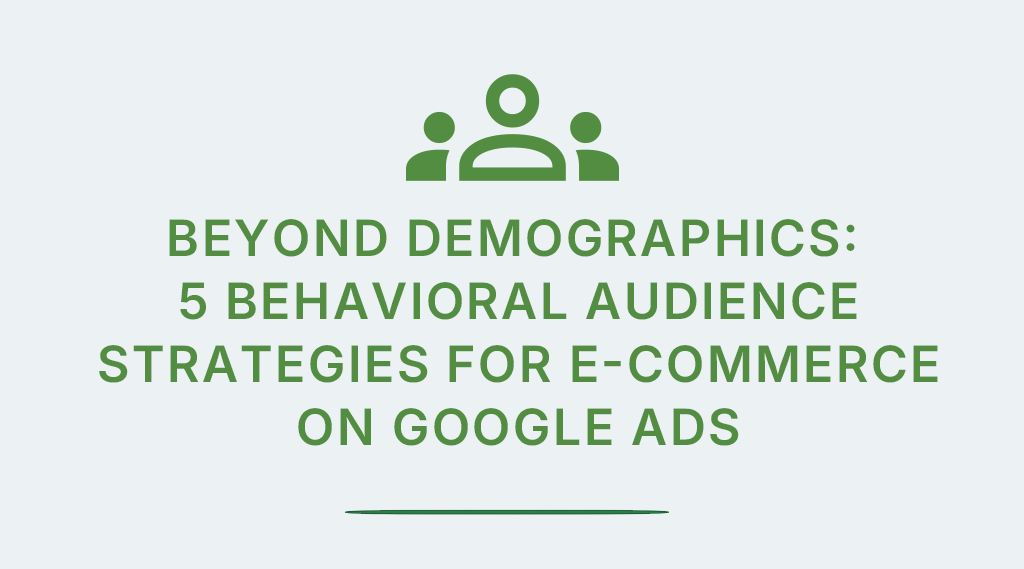Building Meaningful Audiences
In the competitive world of direct-to-consumer (DTC) e-commerce, generic advertising just doesn’t cut it. Your customers are savvy, and their inboxes and social feeds are already cluttered. You need to go beyond basic demographics like age and location. The real power lies in behavioral audience segmentation—understanding what your customers do, not just who they are.
At Tadpull, we help brands leverage their first-party data to create highly-targeted campaigns that convert. Our approach focuses on moving away from broad targeting and toward a hyper-specific, behavioral model. The results speak for themselves: for one of our golf apparel clients, a behavioral list generated over $1 million in revenue in just 90 days by serving hyper-relevant ads to the right people.
Here are five proven behavioral segmentation strategies to elevate your Google Ads campaigns and increase your return on ad spend (ROAS).
1. The “Cross-Sell to Repeat Purchasers” Audience
This is a powerful strategy for any e-commerce brand with a diverse product catalog. Instead of targeting all your past customers with a generic ad, you segment them based on their purchase history to promote complementary products. Some cross-sells are natural (e.g. an attachment to the helmet your customer just purchased), while some are hidden gems only uncovered through data analysis. A customer in the arbor care space uncovered that a $7 item was the key to unlocking a 20% boost to AOV on their subsequent purchase.
Why it works: These are your highest intent customers—they’ve already demonstrated trust in your brand by making a purchase (and recently). The goal is to increase their customer lifetime value (LTV) by showing them products they’re likely to buy next. This is far more efficient than acquiring a new customer.
Example Audience: Customers who have purchased a camera but have never purchased a camera bag or lens.
How to use it on other platforms: This same segmented list can be used for Meta (Facebook/Instagram) retargeting campaigns and personalized email marketing. A “thank you for your recent purchase” email followed by a paid ad showcasing a complementary product creates a powerful, multi-channel customer experience.
2. The “Engaged, but Never Converted” Audience
This audience consists of people who have shown high intent but have yet to make a purchase. They’ve interacted with your brand in meaningful ways, but for some reason, they haven’t crossed the finish line.
Why it works: These leads are “warm.” They’ve done the research and are in the consideration phase of their buying journey. They just need that final nudge—whether it’s an offer, a social proof point, or a reminder. By excluding them from your top-of-funnel campaigns, you can dedicate specific, hyper-focused ad spend to converting them.
Example Audience: Website visitors who added an item to their cart but did not complete the purchase.
How to use it on other platforms: These lists are perfect for a classic Abandoned Cart email sequence, or a Meta ad campaign showcasing customer testimonials or a limited-time free shipping offer to overcome that final hurdle.
3. The “Product-Specific Prospect” Audience
This strategy is about capturing the interest of potential new customers who have shown a clear interest in a specific product category. Instead of a broad brand awareness campaign, you can target them with highly relevant ads.
Why it works: You’re speaking directly to their needs. If someone is searching for “waterproof hiking jackets” and lands on your site, showing them an ad for that exact type of jacket reinforces that you have what they’re looking for, making a conversion more likely.
Example Audience: Users who have visited a specific product page (e.g., your “running shoes” page) more than once in the last 30 days. This can be tuned, based on traffic, to look for engagement criteria such as scroll depth or page interactions so you’re feeding ad platforms with higher intent segments.
How to use it on other platforms: This audience is ideal for a Meta campaign featuring dynamic product ads (DPAs) that automatically show the exact products the user viewed thereby creating an effortless pathway for them to return to your site
4. The “High-Value LTV” Audience
This audience includes your most valuable customers—the ones who spend the most money, purchase most frequently, and stick around the longest. The goal isn’t necessarily to sell them more, but to find more like them.
Why it works: Google’s algorithms are incredibly sophisticated. By feeding it a list of your best customers, you’re training it to find new prospects with a similar behavioral profile. This is the ultimate form of “smart” prospecting, as it leverages your most valuable first-party data even Google isn’t privy to in order to expand your reach with a high degree of precision.
Example Audience: Customers who have purchased at least three times in the last 12 months with a total spend over a certain threshold.
How to use it on other platforms: Lookalike audiences are a staple on Meta. Creating a “Lookalike of your High-Value LTV” audience on both Google and Meta ensures you’re constantly finding new, highly-qualified prospects in a privacy-first world.
Expert Insight: Your “best” customers is a dynamic definition. As you acquire more customers or launch new products, you could have different people meeting this criteria which then changes who Google is looking for. To best deploy this tactic, ensure that the audience is regularly updated (at least monthly). At Tadpull, audience updates and syncs in live time.
5. The “Unsubscribed, but Active” Audience
This might seem counterintuitive, but just because someone unsubscribed from your email list doesn’t mean they’ve lost interest in your brand. They might simply prefer a different communication channel.
Why it works: You’re re-engaging a once-interested audience without risking your email deliverability. Since they’re no longer on your active email list, you can use paid channels to reconnect with them. This is a crucial strategy for brands looking to maintain a healthy email program while still retaining the potential to convert these individuals.
Example Audience: Past customers who unsubscribed but have recently searched for your brand on Google.
How to use it on other platforms: This is a perfect list to upload to both Google and Meta’s Customer Match features. You can run a low-budget, high-impact campaign that reminds them of your brand and perhaps showcases a new product or a piece of valuable content.
By moving beyond simple demographic targeting and embracing these behavioral segmentation strategies, your DTC brand can unlock new levels of efficiency and growth. It’s about working smarter, not harder, to reach the right people with the right message at the right time.

